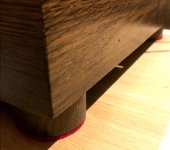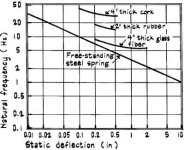Hello - just a quick note to share the virtues of wool felt as a suitable vibration absorbing material. I have been a fan of felt since early vinyl days experimenting with different platter mats, and once again it has come good.
The reason for the post is to share a surprisingly effective solution to a mechanically noisy transformer on a large 211 amp. The amp is heavy and has the typical 50 Hz drone when it is operating. It is not a huge noise and I have been happy to ignore it as it is pretty much inaudible at the listening position. The amp sits on a wall shelf made of 50mm plywood with very strong wall brackets secured by 12mm wall bolts. The amp weighs 50Kg+ (yes really) and the 4 shelf brackets are capable of around 300 Kg together. The amp chassis is made of a combination of 15mm aluminium plate and bog oak which has properties resembling ebony for hardness.
I had previously thought with such high mass, and inherently inert materials the mechanical noise was the transformer within it's mounting.....but today I reduced the hum considerably by placing 3mm thick felt pads under the wooden feet (2" diameter solid wood feet). This was actually no mean feet lifting the amp to get the felt feet pads underneath at each corner....
If you have the opportunity and want to experiment with vibration isolation for very little cost, I cannot recommend felt highly enough. The only real expense is time as the materials cost is minimum.
Good luck
The reason for the post is to share a surprisingly effective solution to a mechanically noisy transformer on a large 211 amp. The amp is heavy and has the typical 50 Hz drone when it is operating. It is not a huge noise and I have been happy to ignore it as it is pretty much inaudible at the listening position. The amp sits on a wall shelf made of 50mm plywood with very strong wall brackets secured by 12mm wall bolts. The amp weighs 50Kg+ (yes really) and the 4 shelf brackets are capable of around 300 Kg together. The amp chassis is made of a combination of 15mm aluminium plate and bog oak which has properties resembling ebony for hardness.
I had previously thought with such high mass, and inherently inert materials the mechanical noise was the transformer within it's mounting.....but today I reduced the hum considerably by placing 3mm thick felt pads under the wooden feet (2" diameter solid wood feet). This was actually no mean feet lifting the amp to get the felt feet pads underneath at each corner....
If you have the opportunity and want to experiment with vibration isolation for very little cost, I cannot recommend felt highly enough. The only real expense is time as the materials cost is minimum.
Good luck
Attachments
Pretty much any compliant mat under each foot that compresses about 40% of its height when the amp is placed on its feet would do. Cheap options that come to mind are rubber sheet, oven silicone products, old mouse mats, old sorbothane foot heel inserts. The ability to compress a certain % is key to the mat acting as a spring (with damping). If you 'dong' the amp and can measure the fundamental resonant frequency of the amp as it vibrates (by an electret microphone or cheap accelerometer), then the aim is for the vibration frequency to be sufficiently below mains frequency that the mat acts as an attenuator to vibration passing to the shelf (the standard principal of industrial vibration attenuators).
...compresses about 40%
.....measure the fundamental resonant frequency .....
The fundamental frequency can be figured from the static deflection.
https://www.industrial-electronics.com/measurement-testing-com/images/aa-279-2.jpg
https://ocw.mit.edu/courses/mechani...ti-dof-vibration/MIT2_003SCF11_rec10note1.pdf
The difficulty in most work is that "sufficiently low" is approximately "annoyingly large deflection".
In a car engine, older cars could want inches of deflection, meaning much clear space under the hood. With control of engine proportions we tend to higher RPM (higher F) engines which can do with less deflection.
Attachments
Yeh I forgot to check my own notes (page 4 of link) on that before posting, soz for the misdirection:
https://www.dalmura.com.au/static/Microphonics%20in%20valves.pdf
https://www.dalmura.com.au/static/Microphonics%20in%20valves.pdf
In a car engine, older cars could want inches of deflection, meaning much clear space under the hood...
I assume you're talking about the deflection in the engine mounts. The large deflection has to do with the engine reaction torque under acceleration, not the engine vibration. Engine vibration never required inches of deflection.
or lack of transfer....it's sort of a mechanical impedance mismatch preventing transfer and absorbing energy
Exactly, you want to lose energy in this case. Like losing magnetic field strength with the addition of barriers from different metals.
Last edited:
Where did you get 50mm plywood?
it's 2 x 25mm PVA laminated together.
I would consider the fire risk with felt.
If the felt is to decouple the TX from the chassis, I would use rubber, my using large grommets on my Nelson-Jones 10+10 in 1972 to good effect.
Now we have the indispensable EPDM rubber, available in many thicknesses. I have veneered one speaker in 1mm EPDM, and use it all the time, eg driver gaskets, and even toilet seat feet.
If the felt is to decouple the TX from the chassis, I would use rubber, my using large grommets on my Nelson-Jones 10+10 in 1972 to good effect.
Now we have the indispensable EPDM rubber, available in many thicknesses. I have veneered one speaker in 1mm EPDM, and use it all the time, eg driver gaskets, and even toilet seat feet.
- Home
- Amplifiers
- Tubes / Valves
- Felt damping

